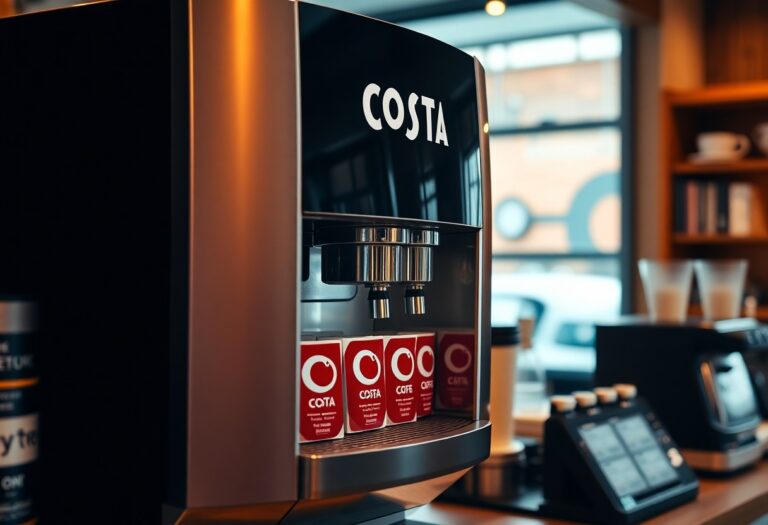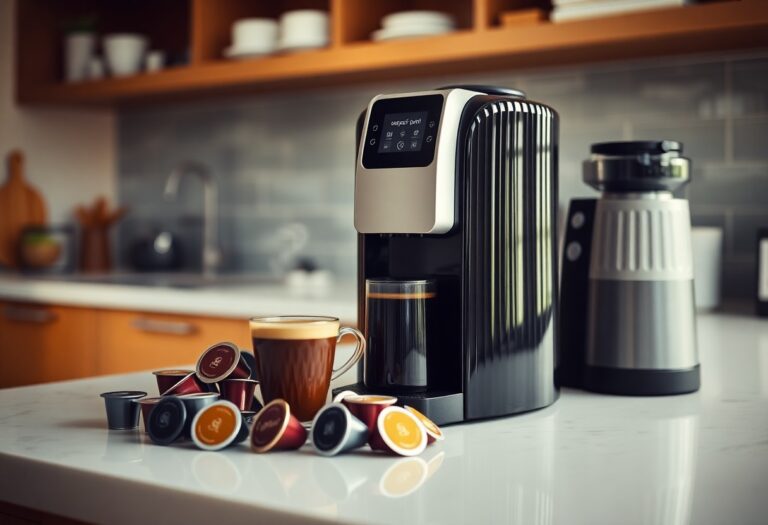How to Descale a Coffee Machine with Vinegar: Natural Method
In this article, you will learn how to descale your coffee machine using a natural method involving vinegar. This method is not only effective but also eco-friendly, providing a safe alternative for maintaining your coffee machine. For more detailed guidance on this natural cleaning method, you can refer to our comprehensive guide. Additionally, if you’re interested in exploring different types of coffee machines, such as the French press, we have a complete explanation available here.
Understanding Limescale and Its Effects on Coffee Machines
Limescale, a common issue in coffee machines, is caused by mineral deposits from water, primarily calcium and magnesium. Here’s what you need to know:
Formation of Limescale
- Limescale forms as water evaporates, leaving behind mineral residues that accumulate over time inside the machine.
- These deposits settle on internal components like heating elements and pipes, hindering performance.
Effects on Coffee Machines
- Brewing Time: Limescale buildup can slow down the brewing process as it affects the heating elements’ efficiency.
- Flavor Quality: Mineral deposits alter the taste of coffee by interfering with the extraction process.
- Overall Performance: The presence of limescale can lead to machine malfunctions and reduced lifespan.
Importance of Regular Descaling
Beyond daily cleaning routines, descaling is crucial to remove stubborn limescale. For instance, if you own a Keurig coffee machine, understanding how to properly descale it can greatly enhance its longevity and performance.
Regular descaling helps maintain optimal machine functionality and ensures the quality of your coffee remains consistent over time.
Essential Maintenance Tips
Incorporating regular descaling into your maintenance routine is vital. If you’re unsure about how to clean your coffee machine effectively, here are some essential maintenance tips that can help.
For specific models like the Cuisinart, following a detailed guide can ensure thorough cleaning. You might find these step-by-step instructions useful.
By understanding how limescale forms and its impacts on your coffee machine, you can appreciate the significance of incorporating descaling into your regular maintenance routine.
Why Vinegar is an Effective Natural Descaler for Coffee Machines
White vinegar is a versatile and effective natural cleaning agent that offers several benefits for descaling coffee machines, including popular models like the Nespresso. Here are some reasons why it’s so effective:
1. Properties of White Vinegar
- Acidity: The acetic acid in vinegar helps dissolve mineral deposits like limescale efficiently.
- Antibacterial Properties: Vinegar can also help eliminate bacteria and mold that may accumulate in the machine.
- Safe for Most Materials: Unlike harsh chemicals, vinegar is gentle on the internal components of the coffee maker.
2. Comparison with Commercial Descaling Products
- Cost-Effectiveness: Vinegar is a budget-friendly alternative to expensive descaling solutions.
- Safety: Commercial descalers often contain chemicals that can be harmful if not rinsed thoroughly. Vinegar, being natural, poses no such risks.
- Environmental Impact: Using vinegar aligns with eco-friendly practices as it is biodegradable and non-toxic compared to chemical cleaners.
For instance, when descaling a Nespresso coffee machine, which you can learn more about in this Nespresso model comparison guide, using white vinegar can be an efficient and safe method.
Preparing Your Coffee Machine for a Vinegar Descaling Treatment
When it comes to descaling your coffee machine with vinegar, proper preparation is key to ensure effective results and safety. Here are the essential steps to get your coffee maker ready for the descaling process:
1. Gather materials needed
Before you begin, make sure you have white vinegar and water on hand. These two simple ingredients will work together to break down the mineral deposits inside your machine.
2. Correct mixture ratio
The ideal vinegar-water solution ratio for descaling is half vinegar and half water. This balanced mixture will effectively target limescale buildup without being too harsh on your coffee maker. For more detailed information about the proper ratios, check out this guide.
3. Important safety tips
Before starting the descaling process, it’s crucial to take some safety precautions:
- Ensure your coffee machine is unplugged and cooled down before handling any parts.
- Open windows or ensure good ventilation in the area to avoid inhaling strong vinegar fumes.
- Wear gloves to protect your skin from the acidic nature of vinegar.
By following these steps, you can prepare your coffee machine properly for a successful descaling treatment using vinegar. If you’re looking for a comprehensive guide on how to clean your coffee machine with vinegar using a DIY method, this resource provides valuable insights.
Step-by-Step Guide to Descale a Coffee Machine Using Vinegar
To effectively descale your coffee machine using vinegar, follow these simple steps:
1. Filling the Reservoir
Start by mixing equal parts of white vinegar and water to create a descaling solution. Pour this solution into the water reservoir of your coffee machine.
2. Running a Full Brewing Cycle
Turn on your coffee maker and run a full brewing cycle with the vinegar-water solution. This process allows the acidic properties of the vinegar to pass through the internal components of the machine, breaking down and dissolving mineral deposits such as limescale. If you own a specific type of coffee machine like a Cuisinart, you might find our detailed guide on how to descale a Cuisinart coffee machine helpful.
3. Letting the Solution Sit
Depending on the manufacturer’s recommendations or if there is heavy buildup of mineral deposits, you may need to let the vinegar solution sit inside the coffee machine for a while. This extra time allows for better penetration and thorough descaling.
By following these steps, you can effectively remove limescale and mineral deposits from your coffee machine using a natural and eco-friendly descaling method. Regular descaling with vinegar helps maintain optimal performance and prolongs the lifespan of your beloved coffee maker.
If you’re looking for more cleaning tips specific to certain brands, we have comprehensive guides available such as our Black and Decker coffee machine cleaning guide.
In case you’re interested in exploring alternative brewing methods while your coffee machine is being cleaned or descaled, our article on manual brewing methods could provide some useful insights. Also, if you own a French press coffee machine, don’t miss out on our French press brewing technique guide.
Post-Descaling Cleaning and Maintenance Tips for Your Coffee Machine
Running multiple cycles with fresh water is crucial post-descale to ensure all traces of vinegar are eliminated, preventing any unwanted taste or smell in your next brew. This step will also help flush out any loosened mineral deposits from the descaling process.
Hand-washing removable components such as the filter holder, carafe, and drip tray is recommended to thoroughly clean these parts. If dishwasher-safe, these components can be placed in the dishwasher for added convenience. For specific cleaning instructions, you might find our guides on cleaning a K-cup coffee machine, cleaning a drip coffee machine, and cleaning a Ninja coffee machine helpful.
Wiping down the exterior surfaces of your coffee machine with a damp cloth and mild detergent helps remove any residual vinegar or water stains. Ensuring all compartments are dried properly post-cleaning prevents mold or mildew growth.
By following these cleaning and maintenance tips after descaling your coffee machine, you can maintain its performance and ensure a fresh and flavorful cup of coffee every time.
How Often Should You Descale Your Coffee Machine? A Maintenance Schedule Guide
Factors influencing descaling frequency include water hardness and usage rate. The harder the water and the more frequently you use your coffee maker, the more often descaling is needed. Here are some key points to consider:
1. Water Hardness
- Hard water contains high levels of minerals like calcium and magnesium that contribute to limescale buildup in coffee machines.
- The harder your water, the faster mineral deposits accumulate inside the machine, necessitating more frequent descaling.
2. Usage Rate
- Daily coffee drinkers will need to descale more often than occasional users due to the higher frequency of brewing cycles.
- Regular use increases the chances of mineral buildup, affecting the taste and performance of your machine.
For those with hard water and daily usage, a monthly descaling routine is recommended. This proactive approach helps maintain optimal machine performance, ensures a great tasting brew, and extends the lifespan of your coffee maker. By incorporating descaling into your regular maintenance schedule, you can enjoy consistently delicious coffee without worrying about limescale-related issues.
Here are some specific guides for descaling different types of coffee machines:
- For Breville coffee machines, a monthly descaling routine can help maintain optimal performance.
- If you’re using a Keurig coffee machine, following a detailed step-by-step guide for descaling can greatly improve its lifespan and efficiency.
- For Mr. Coffee machines, regular cleaning and descaling are essential for maintaining great taste in your brew.
- If you’re looking for an ultimate maintenance guide for cleaning Keurig machines, it’s important to incorporate both cleaning and descaling into your routine.
Remember, prevention is key when it comes to limescale buildup. Using filtered or softened water can reduce mineral concentration and slow down the formation of deposits in your coffee machine, ultimately reducing the frequency of required descaling sessions.
Additional Tips to Prevent Limescale Build-Up in Your Coffee Machine
To effectively minimize limescale build-up in your coffee machine, consider the following practices:
1. Use Filtered or Softened Water
Using [filtered or softened water](https://www.coffeemakerexpert.com/how-to-use-a-hamilton-beach-coffee-machine-operating-guide) helps reduce mineral deposits in your coffee machine. Clean water not only improves the taste of your coffee but also prolongs the lifespan of your machine.
2. Rinse After Each Use
After brewing, it’s crucial to rinse the components of your coffee machine thoroughly with clean water. This step is essential whether you’re using a Hamilton Beach, Keurig, Ninja, or Black and Decker model. Regular rinsing prevents residue accumulation and keeps your machine in optimal condition for longer.
By incorporating these practices into your coffee machine maintenance routine, you can ensure a smooth brewing experience every time.
Conclusion
Make descaling a regular part of your maintenance routine to enjoy better tasting coffee and prolong the lifespan of your coffee machine. Vinegar is a safe, effective, and eco-friendly option for descaling your coffee machine.
Remember, a little care for your coffee machine goes a long way in ensuring a delicious cup of coffee every time!







